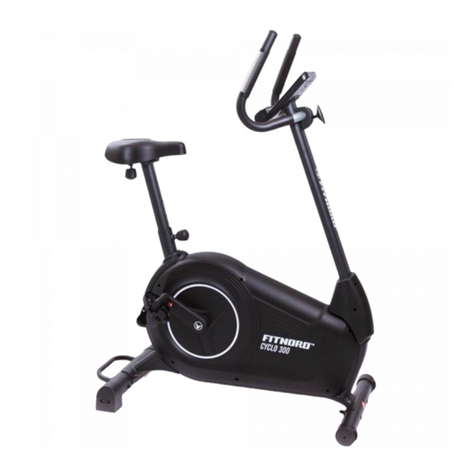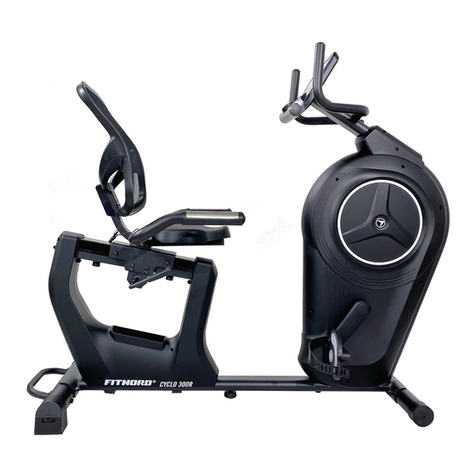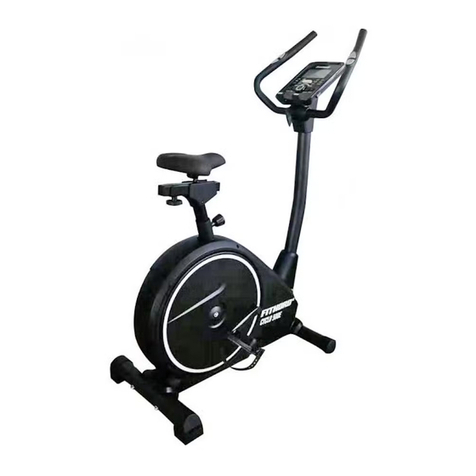FitNord Racer 500 User manual

SPINNING BIKE
USER MANUAL
IMPORTANT!
Please retain this manual for maintenance and adjustment instructions. Your satisfaction is very
important to us.

1
IMPORTANT SAFETY INFORMATION
Thank you for choosing our product. To ensure your safety and health, use this equipment correctly.
It is important to read this entire manual before assembling and using the equipment. Safe and
effective use can only be achieved if the equipment is assembled, maintained and used properly. It is
your responsibility to ensure that all users of the equipment are informed of all warnings and
precautions.
1. Before starting any exercise program, you should consult your physician to determine if you have
any medical or physical conditions that could put your health and safety at risk or prevent you from
using the equipment properly. Your physician’s advice is essential if you are taking medication
that affects your heart rate, blood pressure or cholesterol level.
2. Be aware of your body’s signals. Incorrect or excessive exercise can damage your health. Stop
exercising if you experience any of the following symptoms: pain, tightness in your chest, irregular
heartbeat, shortness of breath, lightheadedness, dizziness or feelings of nausea. If you do
experience any of these conditions, you should consult your physician before continuing with your
exercise program.
3. Keep children and pets away from the equipment. The equipment is designed for adult use only.
4. Use the equipment on a solid, flat level surface with a protective cover for your floor or carpet. To
ensure safety, the equipment should have at least 4 feet (1.2 M) of free space all around it.
5. Ensure that all nuts and bolts are securely tightened before using the equipment. The safety of the
equipment can only be maintained if it is regularly examined for damage and/or wear and tear.
6. Always use the equipment as indicated. If you find any defective components while assembling or
checking the equipment, or if you hear any unusual noises coming from the equipment during
exercise, discontinue use of the equipment immediately and do not use until the problem has
been rectified.
7. Wear suitable clothing while using the equipment. Avoid wearing loose clothing that may become
entangled in the equipment.
8. Do not place fingers or objects into the moving parts of the equipment.
9. The maximum weight capacity of this unit is 300 pounds (135 KG).
10.The equipment is not suitable for therapeutic use.
11.To avoid bodily injury and/or damage to the product or property, proper lifting and moving is
required.
12.Your product is intended for use in cool, dry conditions. You should avoid storage in extreme cold,
hot or humid areas as this may lead to corrosion and other related problems.
13.This equipment is designed for indoor and home use only. It is not intended for commercial use!

2
EXPLODED DIAGRAM

3
PARTS LIST
No.
Description
Qty.
No.
Description
Qty.
1
Main Frame
1
20
Tube Plug
3
2
Front Stabilizer
1
21
Sleeve
4
3
Front End Cap
2
22
V-Shaped Block
1
4
Rear End Cap
2
23
Hex Stopper Screw
1
5
Foot Pad
2
24
Hex Socket Cap Screw
2
6
Carriage Bolt
4
25
Handlebar Post
1
7
Flat Washer
6
26
Handlebar
1
8
Spring Washer
4
27
L-Shaped Knob
1
9
Acorn Nut
4
28
Seat
1
10
Nylon Nut
2
29L/R
Crank
1 pr.
11
Wheel
2
30
Protective Cover
1
12
Rear Stabilizer
1
31
Brake Knob
1
13
Hexagon Socket Head
Screw
2
32
Flat Washer
1
14
Cross Recessed
Countersunk Head Screw
2
33
Hex Screw
2
15L/R
Pedal
1 pr.
34
Inner Hexagon Pan Head
Bolt
2
16
L-Shaped Knob
3
35
Cross Head Screw
2
17
Bushing
1
36
Flat Washer
2
18
Seat Post
1
37
Water Bottle Holder
1
19
Seat Horizontal Post
1

4
ASSEMBLY INSTRUCTIONS
STEP 1:
1. Remove the preassembled 4 Carriage Bolts (6), 4Flat Washers (7), 4 Spring Washers (8),
4 Acorn Nuts (9) and 2 Shipping Tubes (A), from the Main Frame (1) with the Spanner .
2. Attach the Front & Rear Stabilizer (2 & 12)to the Main Frame (1) using 4 Carriage Bolts (6),
4Flat Washers (7), 4 Spring Washers (8) and 4 Acorn Nuts (9) that were just removed.
Tighten and secure with the Spanner
3. Insert the Seat Post (18) into the Main Frame (1), and lock with L Shaped Knob (16).

5
STEP 2:
1. Insert the L Shaped Knob (16) into the
front tube of the Main Frame (1). Tighten
clockwise. Then turn counter-clockwise
to loosen the L Shaped Knob (16) enough
to insert the Handlebar Post (25).
2. Insert the Handlebar Post (25) to the front
tube of Main Frame (1), adjust to the
proper height, and insert and tighten L
Shaped Knob (16) to secure.
3. Attach the Handlebar (26)to the
Handlebar Post (25). Insert L Shaped
Knob (27) and Flat Washer (32) and
tighten to secure.
4. Attach the Seat (28) to the Seat Horizontal
Post (19). Tighten and secure with the
Spanner
NOTE: Before exercise, make sure the Seat
(28) is securely tightened to the Seat
Horizontal Post (19).
NOTE: ADJUSTING THE SEAT POST AND
THE SEAT HORIZONTAL POST
When the Seat Post (18)is at the lowest
setting, the handles on L Shaped Knobs (16)
may not have enough space to turn (See
drawing on left). If this happens, the handles
can be adjusted.
To adjust the handle, pull on the handle, turn
to a position that is not blocked, and release.
Repeat as needed. It may take several
adjustments to get the handle to a position
where it can be turned.

6
STEP 3:
IMPORTANT!
Read instructions carefully, failure to do so may cause permanent damage to your bike.
1. Make sure you have the Left Pedal (15L) in hand. Align the Left Pedal (15L) with the Left
Crank (29L)at 90°and gently insert the Left Pedal (15L) into the Left Crank (29L).
2. Screw the Left Pedal (15L) COUNTER-CLOCKWISE into the Left Crank (29L). Tighten and
secure with Spanner.
3. Align the Right pedal with the Right Crank (29R)at 90°and gently insert the Right Pedal
(15R) into the Right Crank (29R). Screw the Right Pedal (15R) CLOCKWISE into the Right
Crank (29R). Tighten and secure with Spanner.
4. Remove the preassembled 2 Cross Head Screws (35) and 2 Flat Washers (36) from the
Main Frame (1) with the Spanner.
5. Attach the Water Bottle Holder (37) to the Main Frame (1) with 2 Cross Head Screws (35)
and 2 Flat Washers (36) by using Spanner.
The assembly is complete!

7
ADJUSTMENTS GUIDE
ADJUSTING THE BALANCE
In order to achieve a smooth and comfortable ride, you must
ensure that the stability of the bike is secured. If you notice
that the bike is unbalanced during use, you should adjust the
foot levelers located beneath the front and rear stabilizers.
To do so, use Spanner to loosen Hex Screw (33)by turning
it clockwise (direction A). With the screw loosened, rotate
Foot Pad (5) until it sits level with the surface that the bike is
on. When you have finished adjusting the foot leveler, use
Spanner to re-tighten the Hex Screw (33)by turning it
counter-clockwise (direction B). If required, repeat this
process to adjust the remaining feet.
ADJUSTING THE RESISTANCE
Adjust the resistance of the bike using the Brake Knob (31).
Increase the level of resistance by turning the tension knob
to the RIGHT (clockwise), decrease the level of resistance
by turning the tension knob to the LEFT (counter-
clockwise). Push down on the Brake Knob (31) for
emergency brake.
ADJUSTING THE SEAT
An appropriate seat height helps to ensure your exercise
efficiency and reduce the risk of injury. Adjusting the seat
forward or backward can help you work out different body
muscle groups.
With one pedal in the upward position, place your foot in the
toe clip and get on the bike. If your leg is bent too much, you
should move the seat up. If your foot cannot touch the pedal
or your leg is too straight, you should move the seat down.
Loosen the L Shaped Knob (16)to raise or lower Seat Post
(18) to the desired position. Make sure L Shaped Knob
(16)secures into the desired hole. Do not raise past the
STOP mark on the post.
Loosen L Shaped Knob (16) to move the seat forward or
backward to the desired position. Once the position is
located, firmly secure L shaped Knob (16)by turning
clockwise.

8
DISMOUNTING THE BIKE
WARNING! Do not dismount the bike or remove your feet
from the pedals until the pedals have stopped completely.
You can stop the flywheel at any time by pushing down on
Brake Knob (31).
ADJUSTING THE HANDLEBAR
Loosen the L Shaped Knob (16)to raise or lower the
handlebar to the desired position. Make sure the L Shaped
Knob (16)settles into the desired hole and secure it firmly
by turning clockwise. See Figure A.
Loosen the L Shaped Knob (27)to move the handlebar
forward or backward to the desired position. Once the
handlebar is in the desired position, firmly secure the L
Shaped Knob (27) by turning clockwise. See Figure B.
ADJUSTING THE PEDAL STRAP
Place the ball of each foot in the toe clips so the front of your
shoe fits in the toe clip cage. Rotate one foot to within arm’s
reach and pull the strap until the top clip cage fits your shoe
snugly. Insert the strap back into the hoop of the toe clip.
Repeat this for the other foot.
MOVING THE BIKE
To move the bike, first ensure that the handlebar is properly
secured. If the handlebar is loose, tighten the L Shaped
Knobs (16 & 27) to secure it. Next, stand at the front of the
bike so that you’re directly in front of the handlebar. Firmly
grasp and hold each side of the handlebar, place one foot on
the front stabilizer and tilt the bike towards you until the
transportation wheels on the front stabilizer touch the
ground. With the wheels on the ground, you can transport
the bike to the desired location with ease.

9
MAINTENANCE INSTRUCTIONS
This is general information for daily, weekly and monthly maintenance to be performed on your bike.
DAILY MAINTENANCE
After each exercise session, wipe down all
the equipment: seat, frame and handlebars.
Pay special attention to the seat post,
handlebar post and belt/chain guard. Sweat
is very corrosive and may cause problems
that require parts replacement later.
1. Get on the bike and start pedaling.
2. Pay attention to any vibrations felt
through the pedals. If you feel any
vibrations, you may need to tighten the
pedals, bottom bracket, or adjust the drive
belt/chain tension.
3. Use a wrench to tighten the pedals until
they are secure.
MONTHLY MAINTENANCE
1. Check that hardware is secure, such as:
water bottle holder, flywheel nuts,
belt/chainguard bolts, brake caliper lock nuts
and brake caliper tension rod nuts.
2. Inspect the brake tension rod for signs of
wear such as missing threads. Clean and
lubricate the brake tension rod.
3. Clean and lubricate the seat post, handlebar
post and seat slider. Remove any build-up of
foreign material.
WEEKLY MAINTENANCE
1. Inspect moving parts and tighten the
hardware.
2. Inspect pull pin frame fittings, making
sure the fittings are snug. Loose frame
fittings may strip out threads over time
and cause extensive damage.
3. Clean and lubricate pop-pin assemblies.
Pull on the pin and spray a small amount
of lubricant onto the shaft.
4. Tighten the seat hardware, making sure
the seat is level and centered.
5. Brush and treat the resistance pads.
Remove any foreign material that may
have collected on the pads. Spray the
pads with silicone lubricant. This helps to
reduce noise from friction between the
pads and the flywheel.
6. Visually inspect the bottom bracket, toe
clips and toe straps. If any of them are
loose or disconnected, attach and tighten.
LEATHER BRAKE PAD CARE (If applicable)
1. Perform this maintenance when the brake
pad is first installed and throughout the brake
pads life. Following these simple guidelines
can increase the life of your brake pads.
2. Some brake pad assemblies are pre-
lubricated. Squeeze the brake pad. If
lubricant is released, then the pad has been
pre-lubricated.
3. If the brake pad is dry, then coat the brake
pad with 3-n-1 oil. Brush the leather with a
clean, wire bristle brush, and apply the oil.
The oil should be allowed to soak into the
pad. Repeat 4-5 times until the pad is
saturated, but not dripping with oil. When the
pad is saturated, it will no longer absorb oil.
4. Inspect the brake pad weekly and lubricate if
needed. The pad should not have a glazed
appearance. If the pad appears glazed, then
brush it with wire brush and apply lubricant
as needed. If any of the sponge padding is
showing through the leather pad, the brake
pad should be replaced.
Table of contents
Other FitNord Exercise Bike manuals
Popular Exercise Bike manuals by other brands

Sunny Health & Fitness
Sunny Health & Fitness SF-B121021 user manual

Monark
Monark 827E instruction manual

Stamina
Stamina 1310 owner's manual

American Fitness
American Fitness SPR-BK1072A owner's manual

Cateye
Cateye CS-1000 (CYCLO SIMULATOR) Service manual

BH FITNESS
BH FITNESS H9158H Instructions for assembly and use















